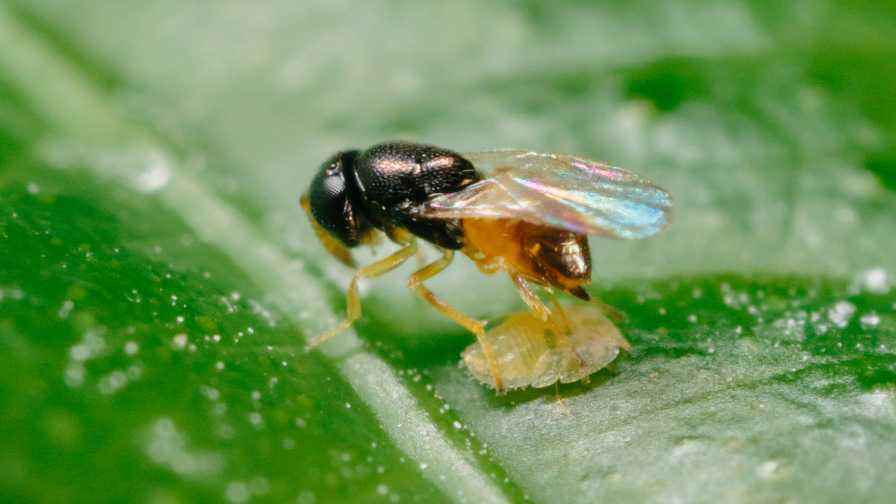Natural Enemies for Asian Citrus Psyllid

Female Diaphorencyrtus aligarhensis ovipositing into an Asian citrus psyllid nymph.
Photo credit: Mike Lewis, Center for Invasive Species Research, University of California Riverside
The eventual spread of Huanglongbing (HLB), or citrus greening, to commercial groves in California seems inevitable. But the devastation seen in Florida and other major citrus production regions may not be.
As you may recall, Western Fruit Grower® reported in January 2016 that Mark Hoddle, a Biological Control Extension Specialist at the University of California, Riverside (UCR), is working in conjunction with the California Department of Food and Agriculture (CDFA) to breed and release large numbers of two parasitic wasps, Tamarixia radiata and Diaphorencyrtus aligarhensis. These wasps are natural enemies of the Asian citrus psyllid (ACP), which vectors citrus greening. After two years of releases, we may be seeing early signs of success in the battle to slow the spread of greening in Southern California.
Building Parasitoid Populations
Both Diaphorencyrtus and Tamarixia were originally collected in Punjab, Pakistan, where they are long-established ACP parasitoids. Tamarixia and Diaphorencyrtus were first released in California in December 2011 and 2014, respectively. Hoddle and his lab helped establish a breeding program for these two species of natural enemy at UCR, and maintain small colonies there. CDFA, which has a rearing facility in Riverside, handles much of the mass production and manages the releases throughout Southern California.
Hoddle says CDFA has released about 300,000 Diaphorencyrtus throughout Southern California and his lab has made recoveries of the wasp at release and non-release sites weeks or even months later.
“[In late March] they recovered Diaphorencyrtus in Pomona. The last release there had been in November of 2016,” Hoddle says.
That’s important because it showed the wasps were able to overwinter in the region.
“It wasn’t as much of a surprise as it was a relief,” he says. “We are encouraged that it may be able to establish in California, even in times of year where the weather isn’t conducive and Asian citrus psyllid populations are down.”
Diaphorencyrtus has been recovered at 60% of release sites. Parasitism levels have been variable throughout the year, from 0% to 1% all the way to 50%, although the reasons for this wide range of attack are still a little unclear, Hoddle says. The wasps could still be filling in space between the areas where releases took place, or having to recolonize after periods when ACP populations drop off.
Perhaps some of the best news is that Diaphorencyrtus has been found up to 3 to 4 miles away from where it was released. That’s crucial, because rather than release Diaphorencyrtus and Tamarixia directly into commercial groves — where they would likely be impacted by sprays or other challenges — the strategy has been to take advantage of the large number of residential citrus trees throughout the region and make releases largely in urban areas. The goal is to establish populations there and then allow them to move into commercial groves on their own.
CDFA, for example, is releasing predators in community gardens in San Bernardino near commercial production areas.
“We are building urban reservoirs of ACP natural enemies. We are hopeful that Diaphorencyrtus may be establishing in some areas and the time is coming in the next year or so where we won’t be doing more releases in the Southern California region. We will have done all we can,” Hoddle says.
The next step would be to move up and do releases in urban areas in the San Joaquin Valley to inoculate that region, he says.
The Goal: Stem HLB’s Spread
Hoddle is confident Diaphorencyrtus and Tamarixia can coexist in citrus groves, doing double duty on ACP.
“[In Pakistan] we saw Tamarixia achieve about 30% parasitism on average and Diaphorencyrtus was about 20% on average. We’re seeing a similar trend here, at least for Tamarixia and possibly Diaphorencyrtus,” he says.
At those rates, HLB would likely still spread, but not nearly as quickly as in other regions where ACP populations have not been effectively suppressed. As of the end of March 2017, CDFA has confirmed 46 trees with HLB in Hacienda Heights, Cerritos, and San Gabriel, all in Los Angeles County, and all in urban areas. The rate of spread of HLB has been relatively slow, although Hoddle says there are hints from some citrus molecular DNA tests that the pace may now be picking up a little bit.
While results are encouraging so far, eradication of ACP and citrus greening aren’t the goal with the program. Keeping the problem in relative check for the time being is.
“The goal is to slow the progress of ACP and HLB until we can develop solutions that allow people to live with it,” Hoddle says. “Every ACP Diaphorencyrtus or Tamarixia kills is one less growers have to manage.”










